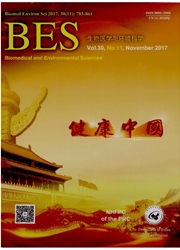

 中文摘要:
中文摘要:
识别并且决定最佳的方法到屏蔽为的目的在下面胎儿是症候群(DS ) 。方法三个大队与 17 118 , 39 903 , 16 646 个题目为第一个三个月被注册屏蔽的两倍标记(联系怀孕的血浆蛋白质 A 和免费人的 chorionic gonadotropin )( FTDMS ),第二个三个月屏蔽的两倍标记( -fetoprotein 和免费人的 chorionic gonadotropin )( STDMS ),并且第二个三个月三元组标记(-fetoprotein,免费人的 chorionic gonadotropin 和 unconjugated 雌素三醇 3 )屏蔽( STTMS )分别地。敏感,特性,假积极的率(FPR ) ,假否定的率(FNR ) 和在巨鸟曲线(AUC ) 下面的区域被估计以便不到以上 35 岁在女人决定最佳的屏蔽方法。不到 35 岁的女人,的结果 STTMS 是有 68.8% 的察觉率的最好的方法, 4.3% 的 FPR 与 66.7% 的察觉率(敏感) 和 4.9% 的 FPR 由 STDMS 列在后面。FTDMS 有 61.1% 的更低的察觉率和 6.3% 的 FPR。为超过 35 岁的女人,所有方法的察觉率是类似的,但是 STTMS 方法有 15.9% 的最低 FPR。为在 35 岁 AUC 下面的女人是 0.77 (95% CI, 0.64 ~ 0.91 ) , 0.81 (95% CI, 0.71 ~ 0.91 ) ,并且 0.82 (95% CI, 0.69 ~ 0.96 ) 为 FTDMS, STDMS,和 STTMS 方法分别地;为上面的那些 35 岁, AUC 是 0.70 (95% CI, 0.56 ~ 0.83 ) , 0.70 (95% CI, 0.59 ~ 0.82 ) , 0.78 (95% CI, 0.58 ~ 0.97 ) 为 FTDMS, STDMS 和 STTMS 分别地。从我们的学习的结论调查结果表明 STDMS 为在不到 35 的怀孕女人的胎儿的 DS 的察觉是最佳的。为单个女人,如果经济状况允许,, STTMS 为超过 35 变老的女人是最好的选择, STTMS 是最好的选择在这方面。
 英文摘要:
英文摘要:
Objective To identify and determine the optimal method to screening for fetal Down's syndrome (DS). Methods Three large cohorts with 17 118, 39 903, 16 646 subjects were enrolled for the first trimester double marker (pregnancy-associated plasma protein A and free [B-human chorionic gonadotropin) screening (FTDMS), second trimester double marker (c{-fetoprotein and free B-human chorionic gonadotropin) screening (STDMS), and second trimester triple marker (a-fetoprotein, free 13-human chorionic gonadotropin and unconjugated estriol 3) screening (STTMS), respectively. The sensitivity, specificity, false positive rate (FPR), false negative rate (FNR) and the areas under ROC curves (AUCs) were estimated in order to determine the optimal screening method in women under or above 35 years old. Results For women under 35 years old, STTMS was the best method with a detection rate of 68.8% and FPR of 4.3% followed by the STDMS with a detection rate (sensitivity) of 66.7% and FPR of 4.9%. The FTDMS had a lower detection rate of 61.1% and FPR of 6.3%. For women above 35 years old, the detection rate of all the methods was similar, but STTMS method had a lowest FPR of 15.9%. For women under 35 years old AUCs were 0.77 (95% CI, 0.64 to 0.91), 0.81 (95% CI, 0.71 to 0.91), and 0.82 (95% CI, 0.69 to 0.96) for FTDMS, STDMS, and STTMS methods, respectively; for those above 35 years old, AUCs were 0.70 (95% CI, 0.56 to 0.83), 0.70 (95% CI, 0.59 to 0.82), 0.78 (95% Cl, 0.58 to 0.97) for FTDMS, STDMS and SITMS, respectively. Conclusion Findings from our study revealed that STDMS is optimal for the detection of fetal DS in pregnant women aged under 35. For individual women, if economic condition permits, STFMS is the best choice, while for women aged above 35, STTMS is the best choice in this regard.
 同期刊论文项目
同期刊论文项目
 同项目期刊论文
同项目期刊论文
 Molecular cloning and expression analysis of PDR1-like gene in ginseng subjected to salt and cold st
Molecular cloning and expression analysis of PDR1-like gene in ginseng subjected to salt and cold st Gene Expression Profiling in Monocytes and SNP Association Suggest the Importance of the Gene for Os
Gene Expression Profiling in Monocytes and SNP Association Suggest the Importance of the Gene for Os Association study on bone mineral density with SNPs at the regions of 2q24.3, 5q21, 7p21.2 and 13q21
Association study on bone mineral density with SNPs at the regions of 2q24.3, 5q21, 7p21.2 and 13q21 A genome wide association study between copy number variation (CNV) and human height in Chinese popu
A genome wide association study between copy number variation (CNV) and human height in Chinese popu Genome-wide association study suggested copy number variation may be associated with body mass index
Genome-wide association study suggested copy number variation may be associated with body mass index Genome-wide association study suggests that ANKRD7 and CYTL1 are novel risk genes for alcohol drinki
Genome-wide association study suggests that ANKRD7 and CYTL1 are novel risk genes for alcohol drinki Genome-wide association study identifies two novel loci containing FLNB and SBF2 genes underlying st
Genome-wide association study identifies two novel loci containing FLNB and SBF2 genes underlying st Anthropometric indices as the predictors of trunk obesity in Chinese young adults: receiver operatin
Anthropometric indices as the predictors of trunk obesity in Chinese young adults: receiver operatin Proteomic analysis of circulating monocytes in Chinese premenopausal females with extremely discorda
Proteomic analysis of circulating monocytes in Chinese premenopausal females with extremely discorda How is mRNA expression predictive for protein expression? A correlation study on human circulating m
How is mRNA expression predictive for protein expression? A correlation study on human circulating m An in vivo genome wide gene expression study of circulating monocytes suggested GBP1, STAT1 and CXCL
An in vivo genome wide gene expression study of circulating monocytes suggested GBP1, STAT1 and CXCL 期刊信息
期刊信息
